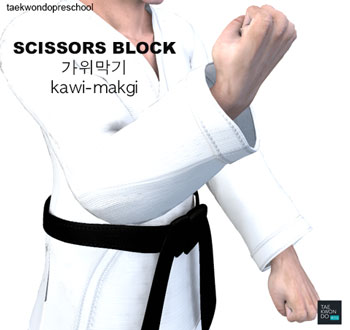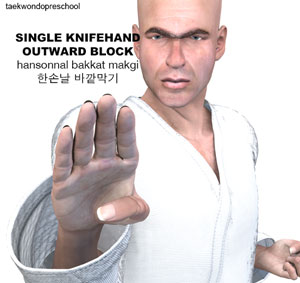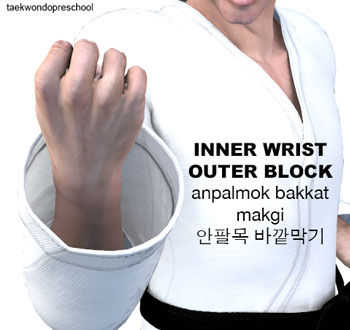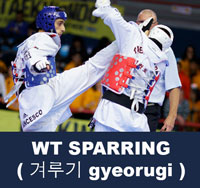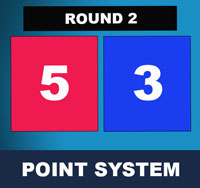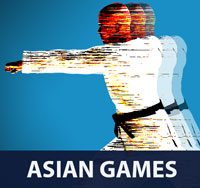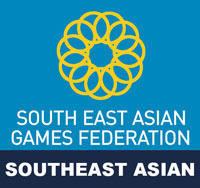Taekwondo 태권도Taekwondo Preschool
In some schools, permission to begin sparring is granted upon entry. The rationale for this decision is that students must learn how to deal with a fast, powerful, and determined attacker. In other schools, students may be required to wait a few months, for safety reasons, because they must first build the skills they would ideally employ in their sparring practice. View Taekwondo Sparring »
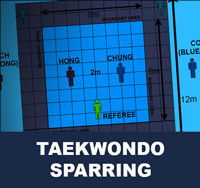
World Taekwondo (WT) Sparring
( 겨루기 gyeorugi )
Sparring is a form of training common to many combat sports. Although the precise form varies, it is essentially relatively 'free-form' fighting, with enough rules, customs, or agreements to make injuries unlikely.
Under World Taekwondo (WT) and Olympic rules, sparring is a full-contact event and takes place between two competitors in an area measuring 8 meters square. A win can occur by points, or if one competitor is unable to continue (knockout) the other competitor wins. Each match consists of three semi-continuous rounds of contact, with one minute's rest between rounds. There are two age categories: 14–17 years and 18 years and older.
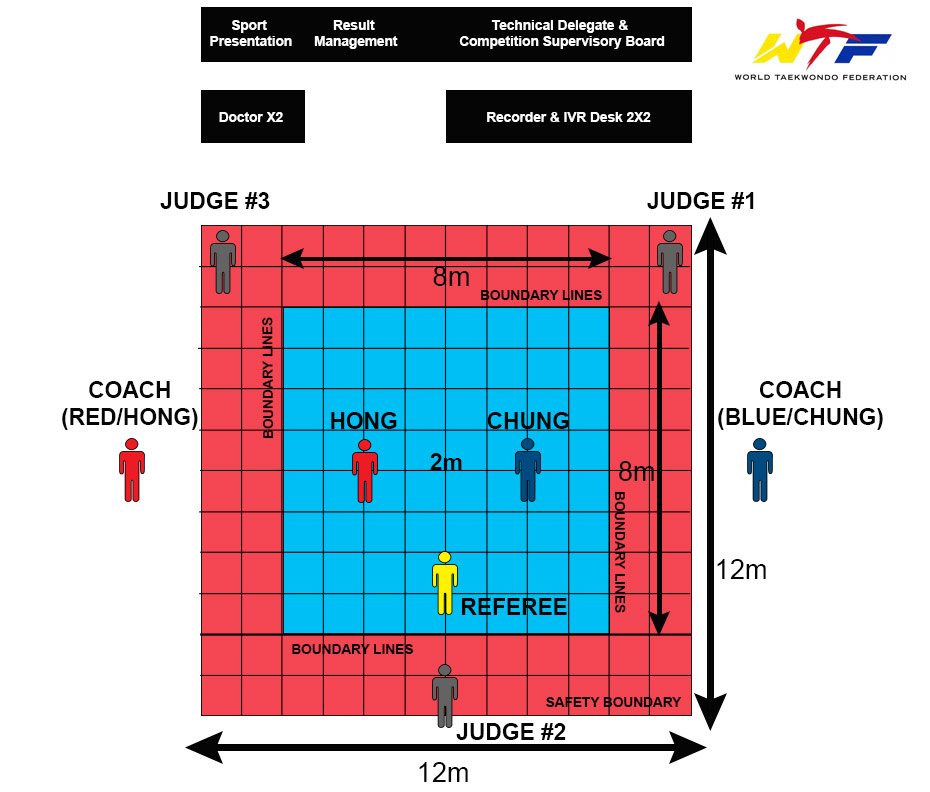
Points are awarded for permitted, accurate, and powerful techniques to the legal scoring areas; light contact does not score any points. The only techniques allowed are kicks (delivering a strike using an area of the foot below the ankle) and punches (delivering a strike using the closed fist). In most competitions, points are awarded by three corner judges using electronic scoring tallies. Several A-Class tournaments, however, are now trialing electronic scoring equipment contained within competitors' body protectors. This limits corner judges to scoring only attacks to the head. Some believe that the new electronic scoring system will help to reduce controversy concerning judging decisions, but this technology is still not universally accepted.
Beginning in 2009, a kick or punch that makes contact with the opponent's hogu (the body guard that functions as a scoring target) scores one point; if a kick to the hogu involved a technique that includes fully turning the attacking competitor's body, so that the back is fully exposed to the targeted competitor during execution of the technique (spinning kick), an additional point is awarded; a kick to the head scores three points; as of October 2010 an additional point is awarded if a turning kick was used to execute this attack. Punches to the head are not allowed. As of March 2010, no additional points are awarded for knocking down an opponent (beyond the normal points awarded for legal strikes).
The referee can give penalties at any time for rule-breaking, such as hitting an area not recognized as a target, usually the legs or groin ( 샅 sat ). Penalties are divided into Warnings ( 경 고 gyeong-go ) and Deduction Penalty ( 감점 gamjeom ). Two Warnings ( 경 고 gyeong-go ) shall be counted as an addition of one (1) point for the opposing contestant. However, the final odd-numbered Warnings ( 경 고 gyeong-go ) shall not be counted in the grand total.
At the end of three rounds, the competitor with more points wins the match. In the event of a tie at the end of three rounds, a fourth 'sudden death' overtime round, sometimes called 'Golden Point', will be held to determine the winner after a one-minute rest period. In this round the first competitor to score a point wins the match. If there is no score in the additional round the winner shall be decided by superiority as determined by the refereeing officials.
Until 2008, if one competitor gained a 7-point lead over the other, or if one competitor reached a total of 12 points, then that competitor was immediately declared the winner and the match ended. These rules were abolished by the World Taekwondo (WT) at the start of 2009. In October 2010 the World Taekwondo (WT) reintroduced a point gap rule. Under the new rule if a competitor has a 12-point lead at the end of the second round or achieves a 12-point lead at any point in the 3rd round then the match is over and the athlete in the lead is declared the winner.
Depending on the type of tournament and club, competitors may also use fist protectors, foot protectors, instep guards, helmets and mouth guards.
Students may be required to wait a few months, for safety reasons, because they must first build the skills they would ideally employ in their sparring ( 겨루기 gyeorugi ) practice. Many schools value sparring because it forces the student to improvise, to think under pressure, and to keep their emotions under control.
* Please see a certified Master Instructor ( 사범님 sabeomnim ) for training. Proper guidance and instructions are needed to ensure safe training.
( Click image for additional information)

Training Safety Precautions
Usually before the taekwondo class starts, the master ( 사범님 sabeomnim ) instructs the students to jog around the dojang to warmup. Depending on the size of the dojang, several laps are done. Risk of injury can be reduced by completing an effective warm-up consisting of a heart raiser to get your pulse up, followed by sport specific dynamic stretches (stretches whilst moving).
* Please see a certified Master Instructor ( 사범님 sabeomnim ) for training. Proper guidance and instructions are needed to ensure safe training.
2013 World Taekwondo (WT) Championships Finals | Puebla, Mexico
2013 World Taekwondo (WT) Championships Male Finals
City and Host Country: Puebla, Mexico 
- 2013 WT World Taekwondo Championships Final | Male +87kg »
- 2013 WT World Taekwondo Championships Final | Male -87kg »
- 2013 WT World Taekwondo Championships Final | Male -80kg »
- 2013 WT World Taekwondo Championships Final | Male -74kg »
- 2013 WT World Taekwondo Championships Final | Male -68kg »
- 2013 WT World Taekwondo Championships Final | Male -63kg »
- 2013 WT World Taekwondo Championships Final | Male -58kg »
- 2013 WT World Taekwondo Championships Final | Male -54kg »
2013 World Taekwondo (WT) Championships Female Finals
City and Host Country: Puebla, Mexico 
- 2013 WT World Taekwondo Championships Final | Female -46kg »
- 2013 WT World Taekwondo Championships Final | Female -49kg »
- 2013 WT World Taekwondo Championships Final | Female -53kg »
- 2013 WT World Taekwondo Championships Final | Female -57kg »
- 2013 WT World Taekwondo Championships Final | Female -62kg »
- 2013 WT World Taekwondo Championships Final | Female -67kg »
- 2013 WT World Taekwondo Championships Final | Female -73kg »
- 2013 WT World Taekwondo Championships Final | Female +73kg »
2013 World Cup Taekwondo Team Championships | Abidjan, Ivory Coast
2013 World Cup Taekwondo Team Championships
City and Host Country: Abidjan, Ivory Coast 
Risk of injury can be reduced by completing an effective warm up consisting of a heart raiser to get your pulse up, followed by sport specific dynamic stretches (stretches whilst moving). Please follow the guidance of a certified Master Instructor or trainer when doing sports related activities. Depending on the intensity of the exercise, cooling down can involve a slow jog or walk, or with lower intensities, stretching can be used. Cooling down allows the heart rate to return to its resting rate. View more information on Warming Up and Cooling Down ».
This article uses material from the Wikipedia articles "Warming Up" and "Cooling Down", which is released under the Creative Commons Attribution-Share-Alike License 3.0.
RESOURCES
This article uses material from the Wikipedia articles "Sparring" and "Taekwondo Competition" which is released under the Creative Commons Attribution-Share-Alike License 3.0.










